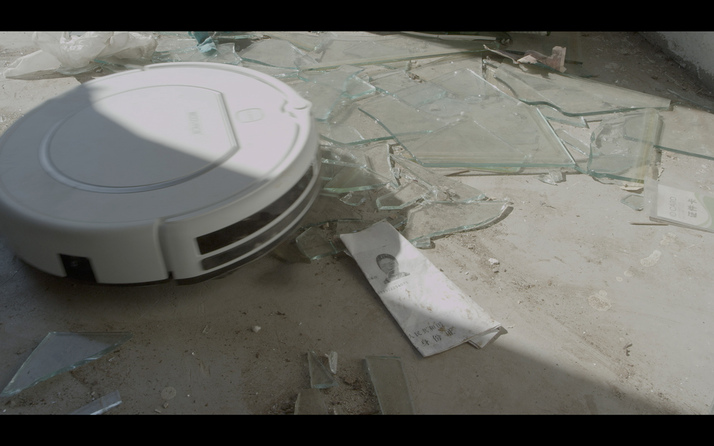-
From Current Issue
-
- Editor’s Letter Fire in the Heart
- Reviews I Gusti Ayu Kadek Murniasih
- Reviews 11th Seoul Mediacity Biennale: “One Escape at a Time”
- Dispatch Networked China
- One on One Monira Al Qadiri on Yukio Mishima
- Essays The rise of independent art spaces in pandemic-era Shanghai
- Features Tuan Andrew Nguyen
- Table of Contents
- Web Exclusives
- Archive
- Subscribe

R
E
V N
E
X
T
Visitors to the TarraWarra Museum of Art generally embark on a one-hour drive from the city of Melbourne to the Yarra Valley region, famous for its lush landscape and wineries; the museum itself being an addition to the TarraWarra Estate, which produces Pinot Noirs and Chardonnays. The nature of this journey—a day trip for most—sits in stark contrast to the travels undertaken by international art-world enthusiasts to Europe for the mega-exhibitions in the region.
“All that is solid…”—presented at the TarraWarra Museum of Art as the third in an exhibition series titled “TarraWarra International”—nevertheless undertook the same, looming examinations of contemporary practices within the global context as the European events. It commendably continued with the containable and effective format of featuring only a handful of artists, as in preceding iterations of the project, showing works by Didem Erk, Cao Fei, Tom Nicholson, Patrick Pound and Cyrus Tang.
In this exhibition, the foundations of the “global”—in particular, archived knowledge—are explored through an allegorical examination of solidity. “All that is solid” does not “melt into air” as Karl Marx proclaimed in his Communist Manifesto of 1848. Instead, the concept of solidity is churned through process- and material-based aesthetic explorations—the outcome reveals the precarious nature of physical matter and historical knowledge, while preserving remnants from the archive.
Many works in the exhibition erode the concept of material density. Tang’s “Lacrimae Rerum" (2016), is aseries of long-exposure photographs that show the gradual collapse of a white-clay city (reminiscent of the urban cityscapes and housing estates of Hong Kong where the artist was born), crumbling and dissolving into a dark, watery abyss. Cao’s video work Rumba II: Nomad (2015), set on a concrete construction site within Beijing’s urban landscape, further reiterates this notion of rapid and utter disintegration, but brings with it a glimpse of renewal. Into this scene of chaos, she drops a tribe of automated robotic vacuum cleaners to offer a modicum of order, although ultimately, their rhythmic dancing and cleaning of the rubble is ineffective. On the other hand, Erk’s site-specific, video-installations from the series “I Wish I Could Not Be Traced in the Archives” (2013–17), show the artist voyaging by foot, reading aloud from Turkish texts, eating each page as she goes along. Her work offers a dialogical and digestive healing process to liberate words and memories from the archive.
PATRICK POUND, Cancelled Archive (detail), 2017, installation with found photographs, dimensions variable. Courtesy the artist, Station, Melbourne, Darren Knight Gallery, Sydney, Hamish McKay Gallery, Wellington and Melanie Roger Gallery, Auckland.
Pound and Nicholson continued this attempt at healing. In his installation, Cancelled Archive (2017), Pound presents a long row of enlarged, documentary-photographic slides displayed in open manila files. Sourced from the Farm Security Administration’s record of the Great Depression of the 1930s, each slide features a round black dot—a puncture mark that indicates the invalidation of these images from the official archive—and represents a resurrection of voided and partly erased memories, reminding us of the dubious nature of all narratives of the past.
Nicholson’s Cartoons for Joseph Selleny (2014) similarly pursues the voids in historical knowledge by exploring a much broader set of research on the convergence of 19th century European and Australian narratives of art and colonial voyage. Nicholson’s work mitigates these histories through an investigation into Renaissance drawing techniques. Accompanying an artist’s book and a suite of cartoons is a vast wall drawing in the museum’s North Gallery. Through the large window in this space, TarraWarra’s picturesque scenery inescapably becomes part of the work. Through this framing of the landscape, we are aptly prompted to recall the colonial and Indigenous history of the land as a site of creation and dispossession.
The works in “All that is solid…” build upon an unsteady foundation of the historical. Together they reconfigure our understanding of the “global” through a process of renewal that aims to aesthetically mitigate between the past and present. Instead of harvesting and obliterating the archive, the artists of the exhibition carry the weight of these histories through their artistic processes. Through the visions of unsteadiness that they have created, we are reminded that “All that is solid…” is comprised of fragments built on unstable ground.
“TarraWarra International 2017: All that is solid…” is on view at the TarraWarra Museum of Art, Healesville, until November 12, 2017.
To read more of ArtAsiaPacific’s articles, visit our Digital Library.









